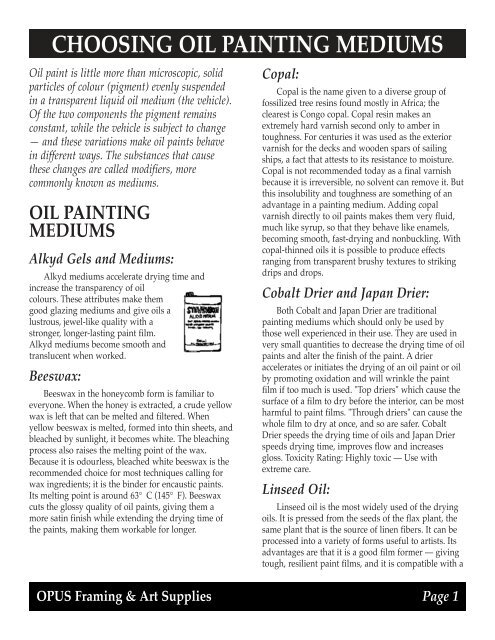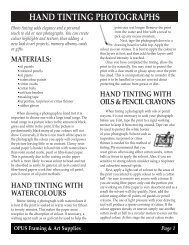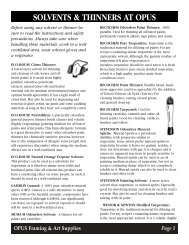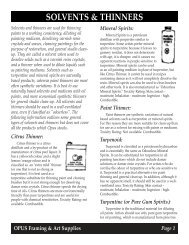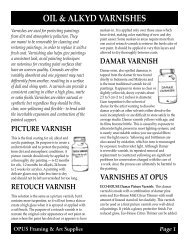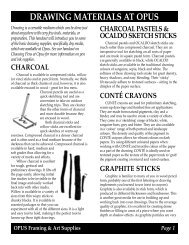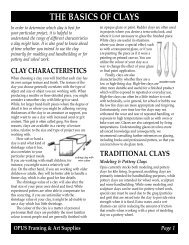Choosing Oil Painting Mediums - Opus Art Supplies
Choosing Oil Painting Mediums - Opus Art Supplies
Choosing Oil Painting Mediums - Opus Art Supplies
You also want an ePaper? Increase the reach of your titles
YUMPU automatically turns print PDFs into web optimized ePapers that Google loves.
CHOOSING OIL PAINTING MEDIUMS<br />
<strong>Oil</strong> paint is little more than microscopic, solid<br />
particles of colour (pigment) evenly suspended<br />
in a transparent liquid oil medium (the vehicle).<br />
Of the two components the pigment remains<br />
constant, while the vehicle is subject to change<br />
— and these variations make oil paints behave<br />
in different ways. The substances that cause<br />
these changes are called modifiers, more<br />
commonly known as mediums.<br />
OIL PAINTING<br />
MEDIUMS<br />
Alkyd Gels and <strong>Mediums</strong>:<br />
Alkyd mediums accelerate drying time and<br />
increase the transparency of oil<br />
colours. These attributes make them<br />
good glazing mediums and give oils a<br />
lustrous, jewel-like quality with a<br />
stronger, longer-lasting paint film.<br />
Alkyd mediums become smooth and<br />
translucent when worked.<br />
Beeswax:<br />
Beeswax in the honeycomb form is familiar to<br />
everyone. When the honey is extracted, a crude yellow<br />
wax is left that can be melted and filtered. When<br />
yellow beeswax is melted, formed into thin sheets, and<br />
bleached by sunlight, it becomes white. The bleaching<br />
process also raises the melting point of the wax.<br />
Because it is odourless, bleached white beeswax is the<br />
recommended choice for most techniques calling for<br />
wax ingredients; it is the binder for encaustic paints.<br />
Its melting point is around 63° C (145° F). Beeswax<br />
cuts the glossy quality of oil paints, giving them a<br />
more satin finish while extending the drying time of<br />
the paints, making them workable for longer.<br />
Copal:<br />
Copal is the name given to a diverse group of<br />
fossilized tree resins found mostly in Africa; the<br />
clearest is Congo copal. Copal resin makes an<br />
extremely hard varnish second only to amber in<br />
toughness. For centuries it was used as the exterior<br />
varnish for the decks and wooden spars of sailing<br />
ships, a fact that attests to its resistance to moisture.<br />
Copal is not recommended today as a final varnish<br />
because it is irreversible, no solvent can remove it. But<br />
this insolubility and toughness are something of an<br />
advantage in a painting medium. Adding copal<br />
varnish directly to oil paints makes them very fluid,<br />
much like syrup, so that they behave like enamels,<br />
becoming smooth, fast-drying and nonbuckling. With<br />
copal-thinned oils it is possible to produce effects<br />
ranging from transparent brushy textures to striking<br />
drips and drops.<br />
Cobalt Drier and Japan Drier:<br />
Both Cobalt and Japan Drier are traditional<br />
painting mediums which should only be used by<br />
those well experienced in their use. They are used in<br />
very small quantities to decrease the drying time of oil<br />
paints and alter the finish of the paint. A drier<br />
accelerates or initiates the drying of an oil paint or oil<br />
by promoting oxidation and will wrinkle the paint<br />
film if too much is used. "Top driers" which cause the<br />
surface of a film to dry before the interior, can be most<br />
harmful to paint films. "Through driers" can cause the<br />
whole film to dry at once, and so are safer. Cobalt<br />
Drier speeds the drying time of oils and Japan Drier<br />
speeds drying time, improves flow and increases<br />
gloss. Toxicity Rating: Highly toxic — Use with<br />
extreme care.<br />
Linseed <strong>Oil</strong>:<br />
Linseed oil is the most widely used of the drying<br />
oils. It is pressed from the seeds of the flax plant, the<br />
same plant that is the source of linen fibers. It can be<br />
processed into a variety of forms useful to artists. Its<br />
advantages are that it is a good film former — giving<br />
tough, resilient paint films, and it is compatible with a<br />
OPUS Framing & <strong>Art</strong> <strong>Supplies</strong> Page 1
CHOOSING OIL PAINTING MEDIUMS<br />
huge number of colorants. Its disadvantages include<br />
yellowing and embrittlement which occur with age<br />
and exposure to light, and an apparent darkening of<br />
the paint film when it is stored in the dark (an effect<br />
reversed by re-exposure to light). These factors are<br />
largely unavoidable.<br />
Cold Pressed Linseed <strong>Oil</strong>:<br />
Made by crushing the flax seed under great<br />
pressure, this is the variety of linseed oil considered to<br />
be the most pure and desirable for<br />
making oil paints. Its colour ranges<br />
from a pale strawlike yellow to a<br />
deeper, golden yellow. It dries<br />
comparatively fast. Cold-pressed<br />
linseed oil was at one time the oil<br />
normally used by commercial paint<br />
makers for artists' paints. Because of<br />
the high cost and low yield of cold<br />
pressing however, refined steam-pressed linseed oil<br />
has largely replaced it.<br />
Stand <strong>Oil</strong>:<br />
A partially polymerized but unoxidized linseed oil<br />
made by heating the oil to abut 300° C (570° F) in the<br />
absence of oxygen. Stand oil is also called heat-bodied<br />
oil. It is not a good binder because it is too viscous,<br />
but it is an excellent addition to painting and glazing<br />
mediums. It yellows less than other forms of linseed<br />
oil and has good leveling properties. Its film gives a<br />
smooth, enamel-like surface without brushmarks.<br />
Poppyseed <strong>Oil</strong>:<br />
Poppyseed oil is extracted from the seed of papaver<br />
somniferum, the poppy plant. It is a pale, nearly<br />
colorless oil that is also used in making artists' whites<br />
and light-colored paints (especially the pale blues).<br />
Poppyseed oil dries rather slowly and some sources<br />
claim that it is susceptible to cracking. It slows drying<br />
time with good colour retention.<br />
NOTES:<br />
OPUS Vancouver OPUS Langley OPUS Victoria<br />
1360 Johnston St 95 - 5501 204 St 512 Herald St<br />
604-736-7028 604-533-0601 250-386-8133<br />
OPUS Kelowna OPUS North Vancouver OPUS National<br />
1357 Ellis St 120 Lonsdale Ave Mail Order Service<br />
250-763-3616 604-904-0447 1-800-663-6953<br />
www.opusframing.com<br />
OPUS Framing & <strong>Art</strong> <strong>Supplies</strong> Page 2


